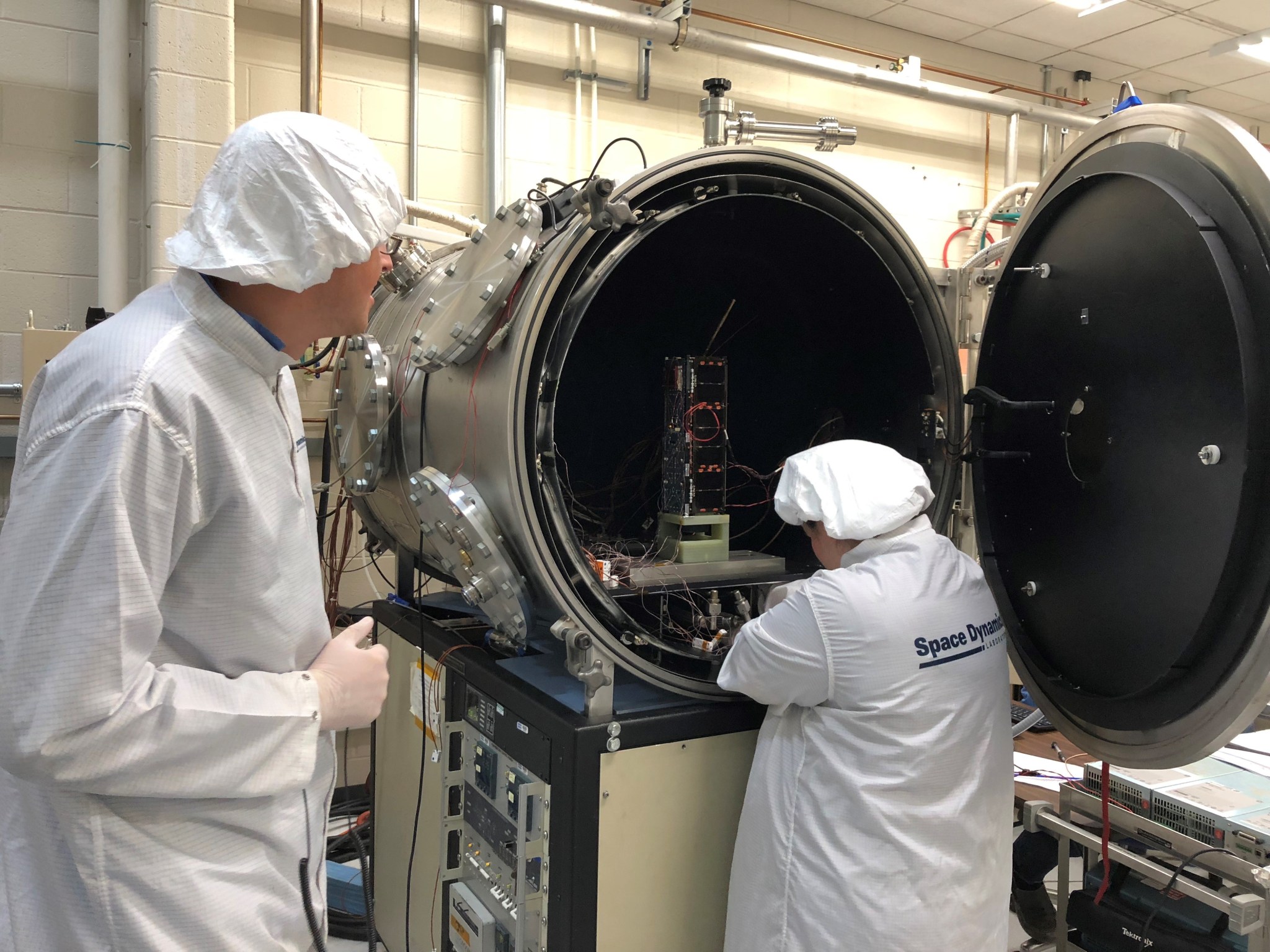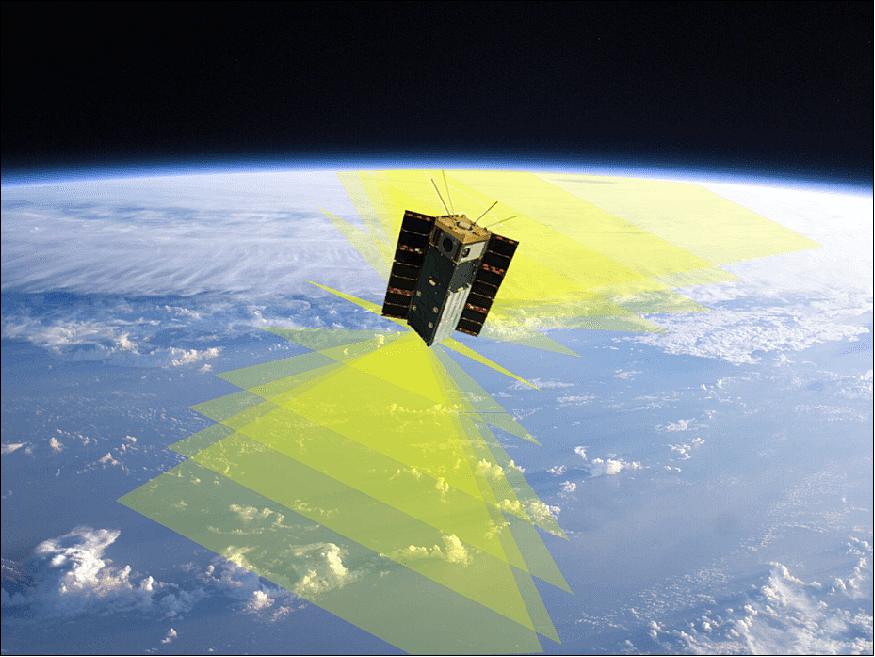NASA’s next attempt to map invisible specks in the atmosphere that impact climate change and air quality started from a window seat over the Pacific.
Vanderlei Martins, a professor at the University of Maryland Baltimore County, was flying across the Pacific Ocean a few years ago when he looked out the window and decided to photograph the bright white clouds floating by. On a whim, he took out a polarizer, similar to a sunglasses lens, and rotated it in front of his camera as he snapped photos. The result? “I saw rainbows in the clouds,” Martins said.
This dynamic view of clouds sparked an idea for a tiny satellite that will launch on Nov. 2 from NASA’s Wallops Flight Facility on Wallops Island, Virginia, to the International Space Station. From there it will be released into Earth orbit.
This NASA-funded CubeSat will collect vital information about clouds and aerosols, tiny particles in the atmosphere that can act as nuclei on which cloud droplets and ice particles form. These measurements will help us better understand how aerosol particles impact weather, climate and air quality.
The Hyper-Angular Rainbow Polarimeter (HARP) CubeSat is about the size of a hearty loaf of bread. It will be the first attempt to put a polarimeter, which measures the polarization of light, aboard a CubeSat. HARP could pave the way for future NASA missions involving a constellation of little satellites peering down at clouds and aerosols, Martins said. NASA’s Earth Science Technology Office is funding HARP under the In-Space Validation of Earth Science Technologies program. Martin in the principal investigator of the mission.
“HARP, as the first multiangle wide field-of-view cloud-aerosol CubeSat mission, is a great example of how a creative and innovative team can advance new technologies for atmospheric science observations,” said Charles Norton, special advisor for small spacecraft missions at NASA Headquarters in Washington.
Cloudy with a chance of rainbows
Naturally produced aerosols, like volcanic smoke, desert dust and sea spray, and human-made aerosols, like smoke from land-clearing fires and sulfate from burning coal and oil, may be invisible to the human eye, but their presence can cast a haze and create bright red sunsets. Aerosols can contribute to poor air quality and impact human health by causing asthma and bronchitis as well as more serious respiratory illnesses.
Aerosols can also alter Earth’s energy balance by reflecting sunlight back into space and altering cloud particles, which also reflect and absorb sunlight. The more light an aerosol reflects, the more it cools the atmosphere; the more light it absorbs, the more it warms the atmosphere. Generally, higher concentrations of aerosol particles lead to more, but smaller, cloud droplets that cause a cloud to brighten and keep it from producing rain. These bright, long-lasting clouds are able to reflect more sunlight and cool the Earth’s system.
Once in orbit, HARP will filter light into four wavelengths and rotate that light to three polarization angles, using its prism. Just as polarized sunglasses help block bright light to help you see when it’s sunny, HARP can block certain wavelengths and make observations from many angles. This reveals otherwise hidden properties of clouds and aerosols, like the amount and type of aerosols in the atmosphere as well as the size of water droplets or ice particles inside clouds. “Every time HARP flies over a region, we see that region from multiple perspectives,” Martins said.
It will also be able to determine how much light is scattered by aerosol particles, said Henrique Barbosa, a professor and scientist with the University of São Paulo in São Paulo, Brazil. “HARP will be able to provide much more information about the microphysical properties of aerosols than was previously available,” said Barbosa, who is collaborating with Martins on HARP and other projects.
However, the team will need to strategically determine when HARP will collect data because it’s a CubeSat with limited power and data capabilities, Barbosa said. For instance, once HARP is in orbit, he would like to have it collect data over the Amazon to learn more about the impact of the ongoing Brazilian Amazon rainforest fires, which have been much larger and more intense than in previous years.
Smoke from the Amazon fires includes soot and aerosols, which can all impact weather and climate. Aerosols from burning biomass to clear land are smaller than natural aerosols. With HARP, scientists could determine whether clouds have smaller, pollution-driven droplets, or larger, naturally derived droplets. HARP’s data could also be combined with ground-based observations and experiments to better extrapolate those results and reveal aerosol processes across a wider region, Barbosa said.
The three HARPs
Martins may have started with the idea for HARP as a CubeSat, but before the tiny satellite could launch, it had two siblings: AirHARP and HARP2.
AirHARP used the same polarimeter technology as HARP but flew aboard two aircraft rather than a satellite in 2017. AirHARP was part of the Lake Michigan Ozone Measurements campaign, which involved a NASA UC12 plane, and the NASA Aerosol Characterization from Polarimeter and Lidar campaign, which obtained aerosol and clouds measurements over the U.S. from the NASA high-altitude ER-2 aircraft.
“We were able to simulate what HARP would do from space,” Barbosa said of AirHARP’s flights. The airborne version helped Barbosa and Martins develop procedures and algorithms that will eventually help download and digest HARP’s data.
However, unlike AirHARP, which was on a set flight path, HARP cannot be controlled once in space. “Once the CubeSat leaves the space station, its course is whatever it will be, and that’s it,” Barbosa said. Once scientists on the ground make contact with the orbiting HARP, they can predict its orbit and turn it on and off when they want to take a measurement over a particular region, but they can’t alter its course.
HARP2, on the other hand, will be a much more powerful version of HARP. HARP2 will fly with NASA’s Plankton, Aerosol, Cloud, ocean Ecosystem (PACE) mission, which is currently under development and plans to improve NASA’s over 20-year record of satellite observations of global ocean biology, aerosols and clouds. Since PACE is a much larger spacecraft with more power capabilities and a much larger team behind it, HARP2 will be able to operate all the time and collect significantly more science data than HARP.
“The HARP CubeSat has perfect timing,” Martins said. “Once we launch it and we get data from it, we will use that data to prepare for HARP2,” he continued.

The little CubeSat that finally could
Although Martins is already planning for the next iteration of HARP, the first almost didn’t happen.
“I want to get as much science as possible,” Martins said, but collecting that much data with a CubeSat is challenging. “HARP is the most technology dense three unit CubeSat we’ve ever attempted,” said Tim Neilsen, the HARP program manager at Space Dynamics Laboratory (SDL) in Logan, Utah. Martins built the instruments and SDL built the CubeSat.

As HARP’s launch approaches, and new opportunities to see and study aerosols draw near, Martins is excited but a little nervous. “Once it launches, you can’t touch it anymore,” Martins said.
HARP is a joint effort between the University of Maryland Baltimore County, Utah State University’s Space Dynamics Laboratory, Science and Technology Corporation.
By: Elizabeth Goldbaum
NASA Earth Science Technology Office































